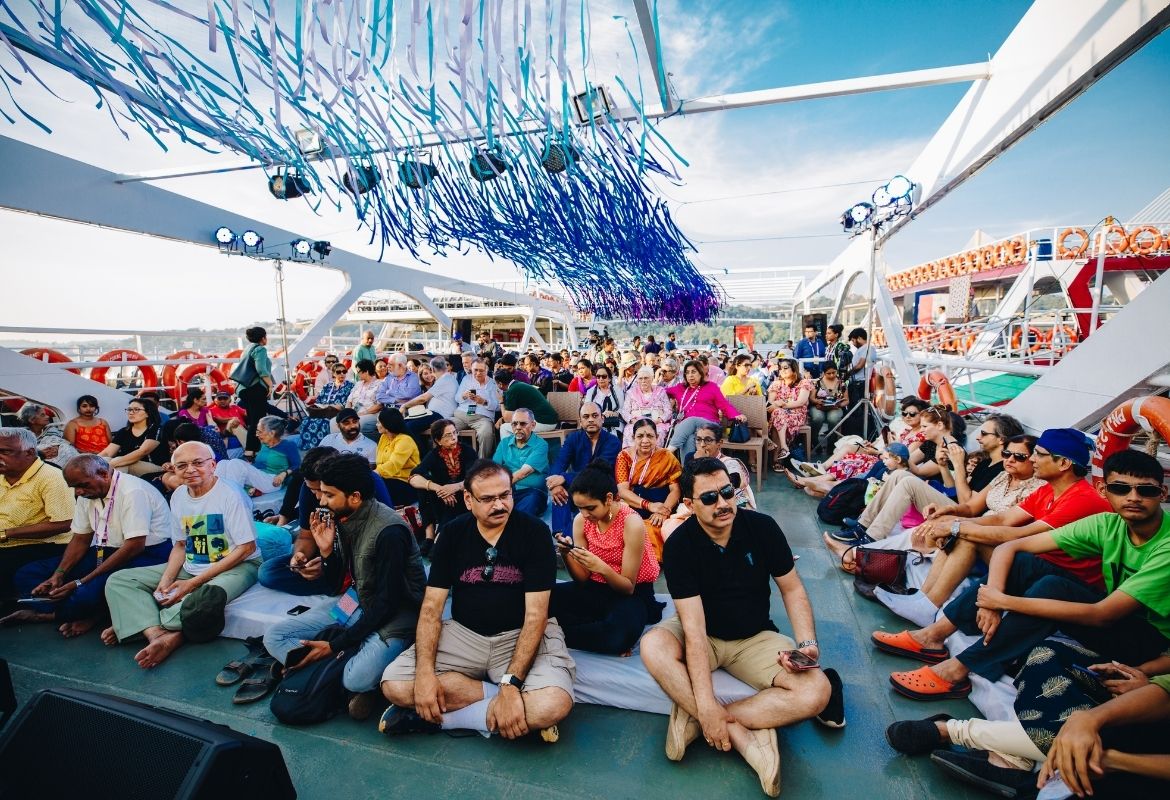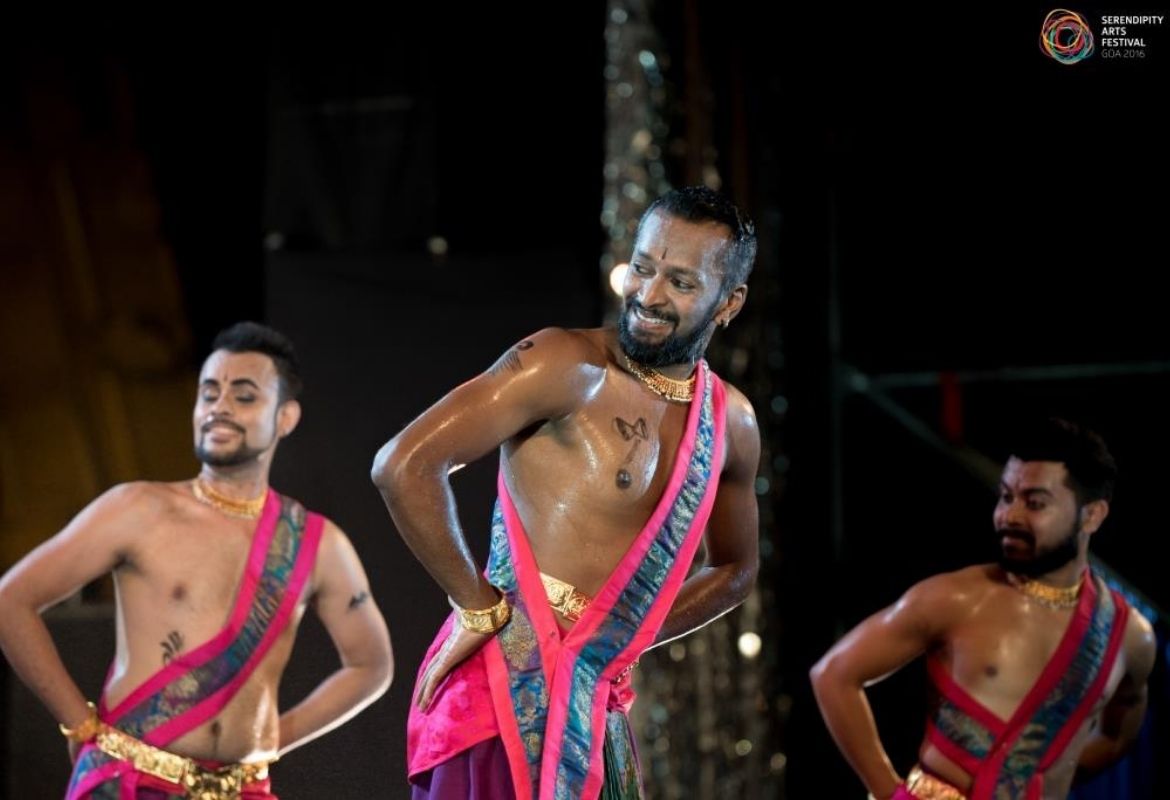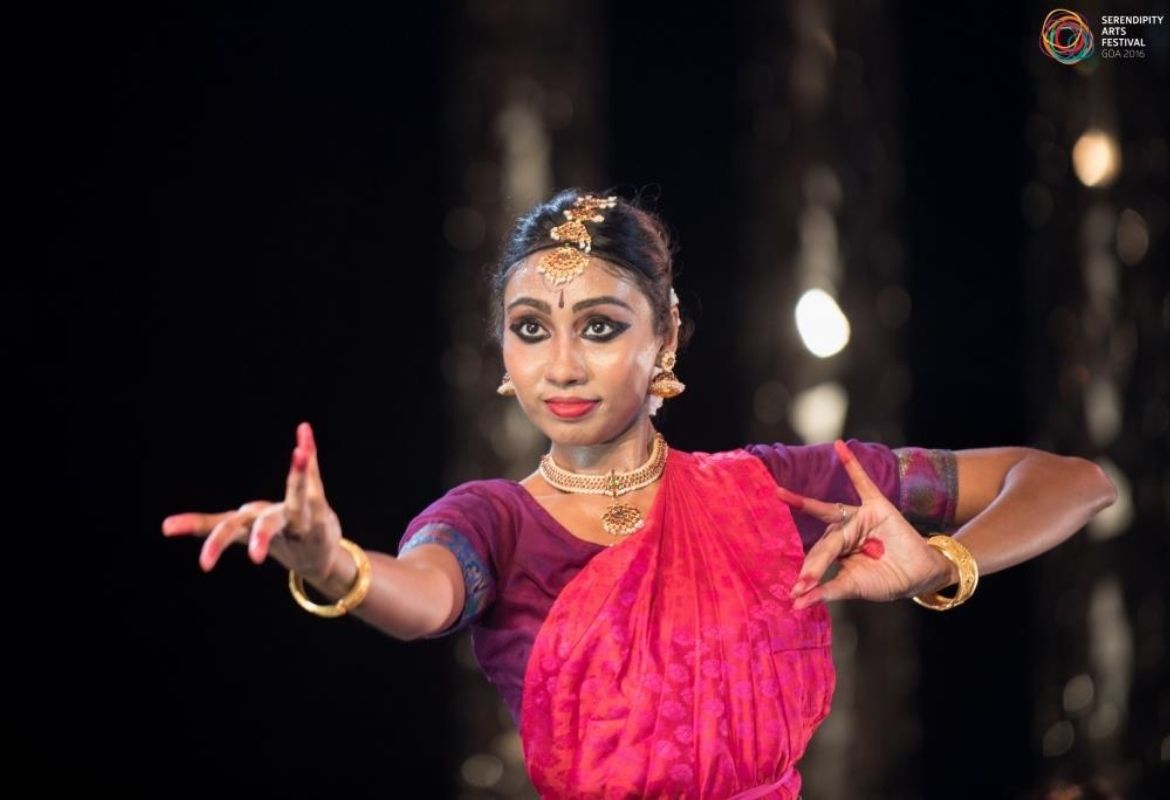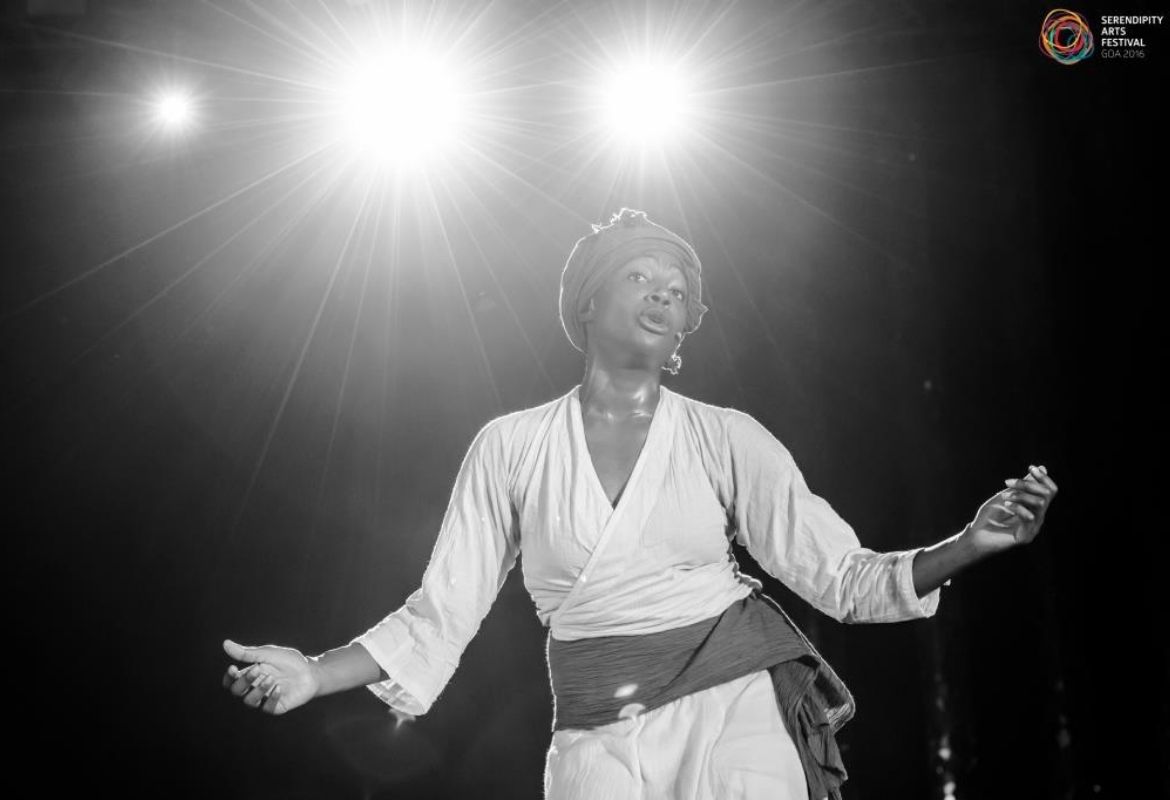River Raga
2019
INTRODUCTION
A sunset cruise along the river Mandovi with a series of curated classical music concerts.
Images courtesy Lumiere Project






CREDITS
2016
Curated by: Shubha Mudgal, Sound Engineer: Nitin Joshi, Artists: Omkar Dadarkar (Hindustani classical Vocal), Raya Korgaonkar (Harmonium), Mayank Bedekar (Tabla)
2017
Curated by: Shubha Mudgal, Sound Engineer: Nitin Joshi, Artists: Indrani Mukherjee (Hindustani classical Vocal), Apurba Mukherjee (Tabla), Raya Korgaonkar (Harmonium), Adrian McNeil (Sarod), Apurba Mukherjee (Tabla), Ramakant Gaikwad (Hindustani classical Vocal), Pandurang Pawar (Tabla), Raya Korgaonkar (Harmonium)
2018
Curated by: Shubha Mudgal, Sound Engineer: Nitin Joshi, Artists: Ashwani Shankar (Shehnai), Sanjeev Shankar (Shehnai), Accompanist: Ojas Adhiya (Tabla), Dhanashree Pandit Rai (Vocal), Accompanists: Kalinath Mishra (Tabla), Niranjan Lele (Harmonium), Aayush Mohan (Sarod), Lakshay Mohan (Sitar), Accompanist: Mayank Bedekar (Tabla), Anuradha Kuber (Vocal), Accompanists: Mayank Bedekar (Tabla), Saumitra Kshirsagar (Harmonium), Aditya Khandwe (Vocal), Accompanists: Mayank Bedekar (Tabla), Raya Korgaokar (Harmonium)
2019
Curated by: Aneesh Pradhan, Sound Engineer: Nitin Joshi, Artists: Chintan Upadhyay (Vocal) Sukhad Munde (Pakhawaj), Ranjani Ramachandran (Vocal), Raya Korgaonkar (harmonium), Mayank Bedekar (Tabla), Vinayak Chittar (Sitar), Mayank Bedekar (Tabla), Jayteerth Mevundi (Vocal), Raya Korgaonkar (harmonium), Uday Kulkarni (Tabla), Arnab Chakrabarty (Sarod), Mayank Bedekar (Tabla)
Sandhi: A CONFLUENCE OF DANCE, MUSIC AND LITERATURE
2016
INTRODUCTION
Each of the four commissioned productions is a confluence of dance, music and literature created by noted dancers and musicians. From each of these creative collaborations between a classical dancer and a classical vocalist emerge new productions with a selected text – compositions by the musician and choreographies by the dancer – both being equally significant aspects of the production.
Curator’s note
The collaboration between a classical dancer and a classical vocalist addresses a serious lacuna in the field of dance—the scarcity of creative dance music. Even though music is an integral part of dance, there is a growing absence of powerful dance music. The reason for this is the increasing chasm between dance and music, where the dancer is seen as the primary figure whereas the musician is viewed as an accompanist. Consequently, many musicians restrain from being a part of dance productions since they feel it might diminish their image as a soloist. This collaborative work seeks to challenge this hierarchy. The productions are true depictions of creative collaborations and have provided an opportunity for interdisciplinary synergy where literature and music within dance are emphasised. As artistes, both the dancers and the musicians had creative space for growth to expand their vision and practice.
New compositions for dance have emerged out of this work that could potentially inspire and infuse the field with more such collaborations in the future. Overall, collaborations such as these would significantly lead to a better quality of music for dance, for posterity. This new space for dialogue between dancers and musicians would draw audiences that are interested in dance as well as music.






Samudra – Mother Ocean
Within each of us is an ocean pregnant with possibilities for creation. Tagore in his poem ‘Samudrer Proti’ addresses the Ocean as the eternal mother of the earth. She is not the stereotyped mother brimming with tenderness and self-sacrifice, put on a pedestal. Rather, she is naïve, impulsive, powerful, animal-like, contradictory – an everyday mother.
According to the Book of Genesis, on the third day, God commanded the waters to recede and make dry land appear. That is the most well known of the stories of the creation. It is matched by legends from several other ancient cultures that speak of the emergence of the universe from an infinite expanse of waters. Tagore in this poem imagines a primordial sea in the process of giving birth to the world, tied to it by an infinitely deep love and longing, almost like a mother’s ties to its child, sometimes fierce and raging resulting in tsunamis, sometimes a gentle lullaby rhythm.
Samudrer Proti gives beautiful imagery for choreography and music, even when we have not used the lines literally. The music is based on Nawaz Mirajkar’s percussion, and Sudha Raghuraman’s Carnatic vocals.
Shivasya Shivaa
It is in Shivaa, his beloved consort, that Shiva, the Adiguru and the ultimate Yogi, finds his foremost disciple and it is in unison with her alone that His beauty and valour become manifest in their finest expressions. Weaving music, narration and movement together, Shivasya Shivaa attempts to explore as also celebrate through an Odissi repertoire the myriad dualities-masculine yet feminine, strong yet gentle, bold yet subtle, forbidding yet appealing, that exist ever so inherently within the human.
Confluence
This performance has been envisioned as a collaboration between two significant structural streams of North Indian Classical arts: dance as well as vocal music. The two artistes will attempt to represent the rich tradition of both these elements in collusion with each other. Music has always been an integral part of Kathak dance but it has a legacy of its own traditional compositions as well. Similarly, Indian classical vocal music has a substantial heritage of ragas, compositions and forms of improvisation. This is a unique collaboration that would bring out the best of both these worlds and will illustrate how they complement each other. The performance will begin with a brief vocal piece and will go on to showcase the legacy of traditional Kathak compositions with reference to the Taala system in Hindustani music. There will be a presentation of vocal compositions from the rich tradition of ‘khayal gayaki’ that will also be interpreted through Kathak, highlighting the nuances and emotions of the text in the bandish. There will also be pieces that showcase the interplay and fast, brisk musical exchanges between these two artistes, exploring the concept of improvisation. The whole performance would weave together all these elements through an exploration of devotional and spiritual themes.
Anubhav
“Do not hold back from telling me any secrets about this universe”, I said.
He spoke into my ear, “Some things cannot be told or understood, only seen and lived within”.
Bhakthi – love that is one of total abandonment, soaked in truth and immersed in that which is real; a throbbing need,an unconditional surrender, an impassioned plea for ecstasy, for liberation, for union. That which emerges from the very core of one’s being and which has been the seed or cause for deepest expression of the self.
See it through the poetry, feel it through the music and live it through the dance.
(An evening of exploration of this love through the words of mystic poets, their worlds, their hearts and their inner selves, expounding on their journeys and their singular quests.)
CREDITS
Curated by Sanjeev Bhargava, Scale Medium, Year of Commission 2016
Samudra – Mother Ocean
Choreography by Amrita Lahiri Conceptualised originally by Sharmila Biswas in 2012 Music Composition: Sudha Raghuraman, Percussion: Nawaz Mirajkar, Flute: Raghuraman , Mridangam: Chandrasekhar, Violin: KP Nandini, Nattuvangam: Kesavan
Shivasya Shivaa
Dancer: Ayona Bhaduri, Flute: Srinibas Satapathy, Mardala: Budhanath Swain, Vocals: Bhuvanesh Komkali, Tabla: Mayank Bedekar
Confluence
Dancer: Eshani Agarwal, Vocals: Ujjwal Nagar, Tabla / Padhant: Rajeev Shukla, Sarangi: Ahsan Ali, Flute: Rohit Prasanna
Anubhav
Artists: Meenakshi Srinivasan, Kaniyal Hariprasad, Jayashree Ramanathan, V. Vedakrishnaram, K.P.Nandini
Natyatra: THE JOURNEY TO BHARATANATYAM
2019
INTRODUCTION
Stemming from Tanusree Shankar’s belief that the eloquent expression of dance is universal, this project envisages the grammar of Indian dance going beyond the traditional and classical. Eight young practitioners of jazz, ballet, contemporary dance, Kathak, Odissi and Kalaripayattu come together under the guidance of Bharatanatyam guru Rama Vaidyanathan to present the well-defined movements of the classical style in a contemporary arrangement.
It takes years to master Bharatanatyam, but through ancient stories and philosophical metaphors, Rama Vaidyanathan acquaints the young dancers with the unparalleled beauty of the classical dance style. The extremely distinct, clear, precise and direct movements of Bharatanatyam will take on a fluid and contemporary vocabulary. Having enabled them to unlock the many rasas of Bharatanatyam, under Rama’s directives these eight dancers have together created three surreal pieces.







CREDITS
Curated by Tanushree Shankar, Choreography by Rama Vaidyanathan, Dancers Sanjukta Ray, Jhuma Das, Debjit Mukherjee, Pranali Shashank Kalkar, Shraddha Rupavate, Subhasish Dey, Ammith M L Kumar, Bhavini Misra, Scale Medium, Year of Commission 2016
Satrangi
2019
INTRODUCTION
This experimental dance project showcases four dancers and two musicians from across the world – exponents of different techniques and styles – coming together to explore various vocabularies through a unique collaboration.
This production has been conceptualised by Tanusree to promote sharing and appreciation across cultures, in the process lifting the invisible barriers across various styles.




CREDITS
Curated by Tanushree Shankar, Dancers Alesandra Seutin, Billy Chang, Subhash Viman, Rukmini Vijayakumar, Musicians Praveen Rao, Pramath Kiran, Eugene Skeef, Scale Medium, Year of Commission 2016
Alesandra Seutin is a London-based choreographer, teacher and performer with African and European roots. She is also the artistic director of the Vocab Dance Company. Her movement – language is a hybrid of contemporary, African and urban dance styles; her choreography combines physical theatre, dance, innovative scenography, live music and text. Her work is political and speaks of social issues such as race, social inclusion and gender from a feminine perspective.
Billy Chang graduated from the prestigious Taipei National University of the Arts and has since been teaching, choreographing and performing. His contemporary choreography is rich both in traditional and modern styles.
Eugene Skeef is a South African percussionist, composer, poet and educationalist who has lived in London since 1980. He works in conflict resolution, acts as a consultant on cultural development and is a broadcaster. He has also been instrumental in developing the education programmes of some of the major classical orchestras in the UK, and has served on the board of directors of the London Philharmonic Orchestra.
UK-born Subhash Viman is influenced by hiphop, urban and contemporary dance styles. He has trained in Bharatanatyam and Kathak under acclaimed teachers in the UK and India. Currently, Subhash is developing his new show with a range of artists exploring the effect bullying has on the physical, mental and spiritual wellbeing of the victim, using movement vocabulary from martial arts.
Rukmini Vijayakumar has trained in Bharatanatyam, as well as in classical ballet, jazz and modern dance in the US. Her performances at many venues in India and abroad include Bharatanatyam at Khajuraho and other festivals. She founded the Raadha Kalpa Dance Company in 2009, and has conducted workshops, choreographed productions, and organized dance arts festivals. She is the director of her Art Space LshVa, in Bangalore.
Bangalore-based Praveen Rao is a versatile multi-instrumentalist with an international reputation. He has composed over 200 scores for leading theatre productions, Indian ballet, films and television across the globe. As a music arranger, he is known for his creativity in fusing Hindustani music, Carnatic music with western techniques and has arranged background scores for various films under acclaimed veteran music directors.
Living Traditions: A CONCERT OF HINDUSTANI CLASSICAL MUSIC REINTERPRETING ARCHIVAL INFORMATION
2019
INTRODUCTION
A classical music performance that is quite unique as it reinterprets archival information both in terms of its musical format as well as its visual presentation. The music renditions pay tribute to the manner in which artistes adapted their presentations for emerging formats like recording technology.
The performers’ costumes, designed by Rohit Bal, are reminiscent of the styles worn by yesteryear musicians and truly reconstruct the essence of the past tradition of musical performance. This collaboration also takes a relook at reviving old textile techniques.
The concept focuses on the spirit of reviving and revitalizing by reconstructing images and archival music from the past with its aspect of theatricality. Curatorial attempts in representing classical music performances in the past have been rare. This project challenges that by using the archival information available in a more engaging manner such that the performance juxtaposes the past styles with the present styles of representations.




CREDITS
Curated by Shubha Mudgal Musicians Kaushiki Chakraborty, Purbayan Chatterjee, Murad Ali , Accompanists Satyajeet Talwalkar, Ajay Joglekar, Yogesh Samsi, Akram Khan, Costumes by Rohit Bal, Set Design by Sumant Jayakrishnan Scale Medium, Year of Commission 2016
Kaushiki Chakraborty, a leading female vocalist of her generation, has performed at all the leading music festivals in the country and in tours abroad. Her gayaki strides effortlessly across khayal, semi-classical genres and beyond. She has also rendered background songs for films.
Purbayan Chatterjee is one of the finest sitar players in Indian classical music. A multifaceted musician, he also performs with musicians from the South Indian raga tradition and participates in various fusion projects including jazz. His music has been appreciated by jazz greats such as Chick Corea and Bella Fleck, and musicians all over the globe. As a fine vocalist, he has lent his soulful voice to many compositions.
Born into a family of musicians originally from Moradabad, Murad Ali is one of the leading sarangi players of the younger generation. He has also participated in cross-cultural and experimental musical endeavours. He is a sixth generation sarangi player who trained under his grandfather Ustad Siddique Ahmad Khan and father Ustad Ghulam Sabir Khan.
LOGIN to see more
To see all the content we have to offer, login below
OR
Don't have an account?
REGISTER FOR FREE
REGISTER FOR FREE
Registration is completely free, stay connected to Serendipity Arts

